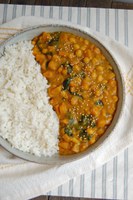Prairie Fare: Add Some Pumpkin to Your Menu
(Click an image below to view a high-resolution image that can be downloaded)
By Julie Garden-Robinson, Food and Nutrition Specialist
NDSU Extension
As I was picking up some dog treats, I stopped in my tracks when I saw the new flavor for fall.
You probably guessed it: pumpkin spice dog treats.
Seriously?
Our three dogs certainly would eat these treats. However, they would eat almost anything that hovers near their mouths.
Pumpkin pie spice remains an ongoing autumn food trend for humans, too. We can enjoy pumpkin spice coffee creamer, coffee drinks, yogurt, pancake mix, cookie straws, candy bars, granola bars, cereal, ice cream, flavored almonds, toaster pastries and dozens more seasonal products available in some locations.
However, having some actual pumpkin with a sprinkle of your favorite spice would be better for your health than some of the high-fat and high-calorie options enticing us in restaurants and grocery stores.
Pumpkins, squash and gourds are part of the family known as Cucurbita. In fact, pumpkins and gourds are types of squash.
Technically, pumpkins and squash are fruits, according to botanists. They are the seed-bearing structure of flowering plants, botanists say.
However, we in nutrition consider pumpkins and squash to be vegetables.
Are you confused yet? Regardless of how you categorize them, enjoy more pumpkin and squash. Most of us do not eat enough dark orange and gold vegetables.
Pumpkin and squash are good sources of fiber to help our digestion. These orange-fleshed fruits of the plant are rich in pigments (called carotenoids) that our body converts to vitamin A. We need vitamin A for healthy eyes and skin.
Pumpkin and winter squash have a long shelf life. Try a variety of winter squash, including butternut, buttercup, acorn, hubbard or spaghetti squash, with these tips:
- Store it correctly. Store pumpkin and squash in a cool, dry place. Do not wash it before storing because that can shorten its storage life. When stored correctly, it can last several months.
- Bake it. To bake a pumpkin or squash, rinse it with running water and scrub with a vegetable brush if needed. Poke holes in the skin with a knife. Place it in a baking pan and bake at 350 F until tender. Bake small squash/pumpkin for about 45 minutes or large squash for about 90 minutes. Remove the skin and seeds, then mash, season as desired and serve.
- Microwave it. Rinse the squash and cut it into chunks. Place in a microwave-safe container and cook on high for about seven minutes until tender. Note: Raw squash and pumpkin are very hard; be cautious when cutting it to avoid injuring yourself.
- Freeze it. Cooked, mashed squash can be preserved by freezing but not by home-canning. Chunks of cooked squash can be preserved by pressure canning. Visit https://www.ag.ndsu.edu/food and follow the directions for safe food preservation.
Try some new recipes. Have you ever made pumpkin pancakes or pumpkin fruit leather? How about pumpkin or squash soup or pumpkin bread pudding? See https://www.ag.ndsu.edu/food for recipes to try. Click on “Recipes,” then “Breads” or “Snacks, Appetizers and Beverages.”
Don’t toss out the seeds. Roast squash or pumpkin seeds. After baking or cooking a squash or pumpkin, remove the seeds and rinse them with water and pat dry with a paper towel. Preheat oven to 300 F. Line a baking sheet with aluminum foil (for easy cleanup). Place the seeds in a bowl, add a small amount of oil and stir. Sprinkle with seasoning salt, Cajun spice or your favorite spice. Bake on the baking sheet for about 45 minutes, stirring every 15 minutes, until the seeds are golden brown.
What recipes do you think of when you hear the word pumpkin or squash? Are you thinking of pumpkin pie or pumpkin bread? Pumpkin and squash can be used in many ways on our menu. Visit https://www.ag.ndsu.edu/food for a variety of pumpkin and squash recipes.
Here’s a fiber-rich recipe with an ethnic flair. Don’t be afraid to try something a little unique now and then.
Pumpkin Chickpea Curry
2 Tbsp. canola oil
1 red onion, diced
1/2 pumpkin or squash, chopped into chunks
2 to 3 garlic cloves, minced
1 small piece of fresh ginger, minced
2 Tbsp. yellow curry powder
5 ounces spinach
1 (14-ounce) can chickpeas, rinsed and drained
1 (13-ounce) can low-fat coconut milk
Lemon juice, if desired
Salt, pepper to taste
Topping (optional):
4 Tbsp. cashew nuts
1 to 2 Tbsp. sesame seeds
Heat the canola oil in a pan or wok. Saute the pumpkin and onion for about three minutes, stirring occasionally. Add garlic, ginger and curry powder and cook for about one to two minutes longer. Then add coconut milk; bring to a boil and simmer 10 minutes over medium heat, stirring occasionally. Add spinach and chickpeas and simmer for five minutes until the spinach has wilted. Add a little water, as needed. Season with salt and pepper to taste. Add a squeeze of fresh lemon juice, if you like. Serve with rice (or other grain of your choice) and top with cashews and sesame seeds.
Makes five (1-cup) servings. Each serving has 250 calories, 11 grams (g) fat, 8 g protein, 35 g carbohydrate, 8 g fiber and 210 milligrams sodium.
(Julie Garden-Robinson, Ph.D., R.D., L.R.D., is a North Dakota State University Extension food and nutrition specialist and professor in the Department of Health, Nutrition and Exercise Sciences. Follow her on Twitter @jgardenrobinson)
NDSU Agriculture Communication - Oct. 17, 2019
| Source: | Julie Garden-Robinson, 701-231-7187, julie.garden-robinson@ndsu.edu |
|---|---|
| Editor: | Ellen Crawford, 701-231-5391, ellen.crawford@ndsu.edu |



